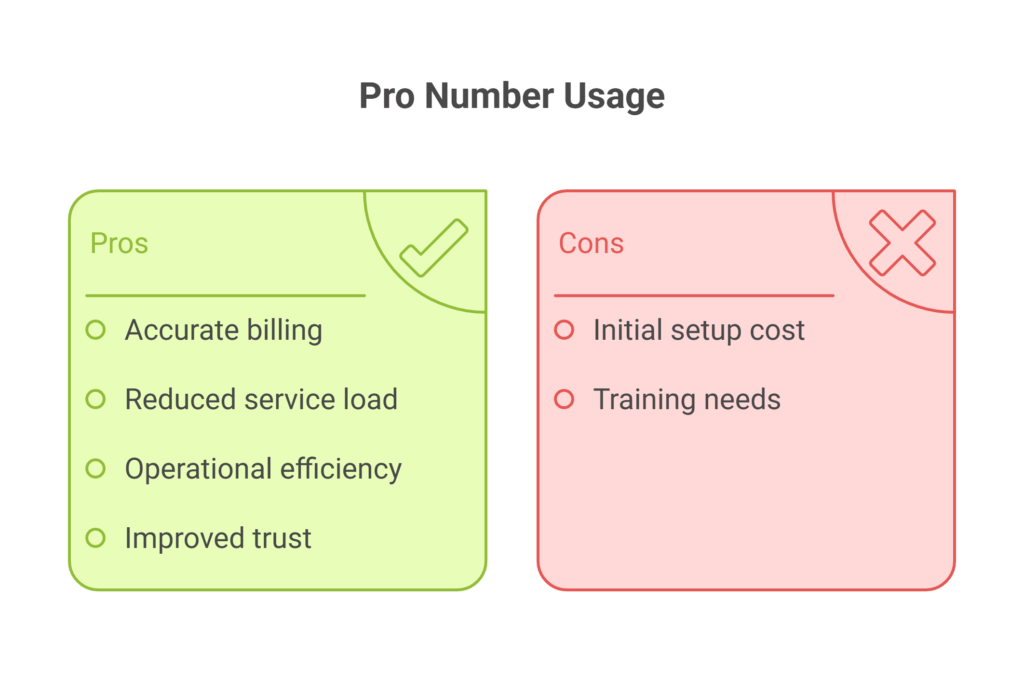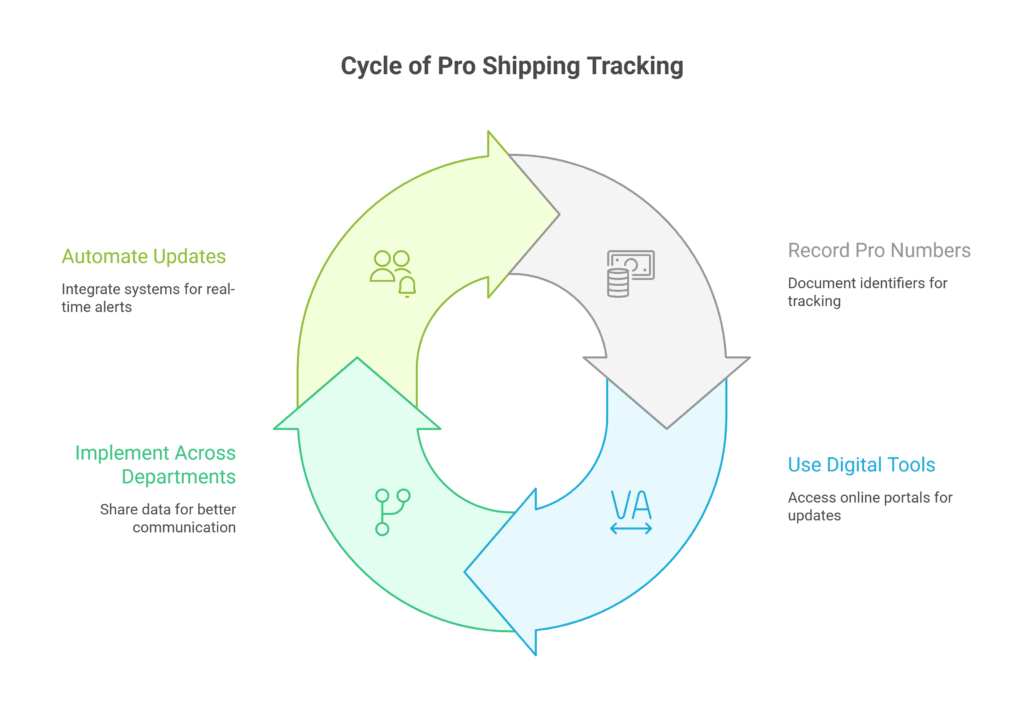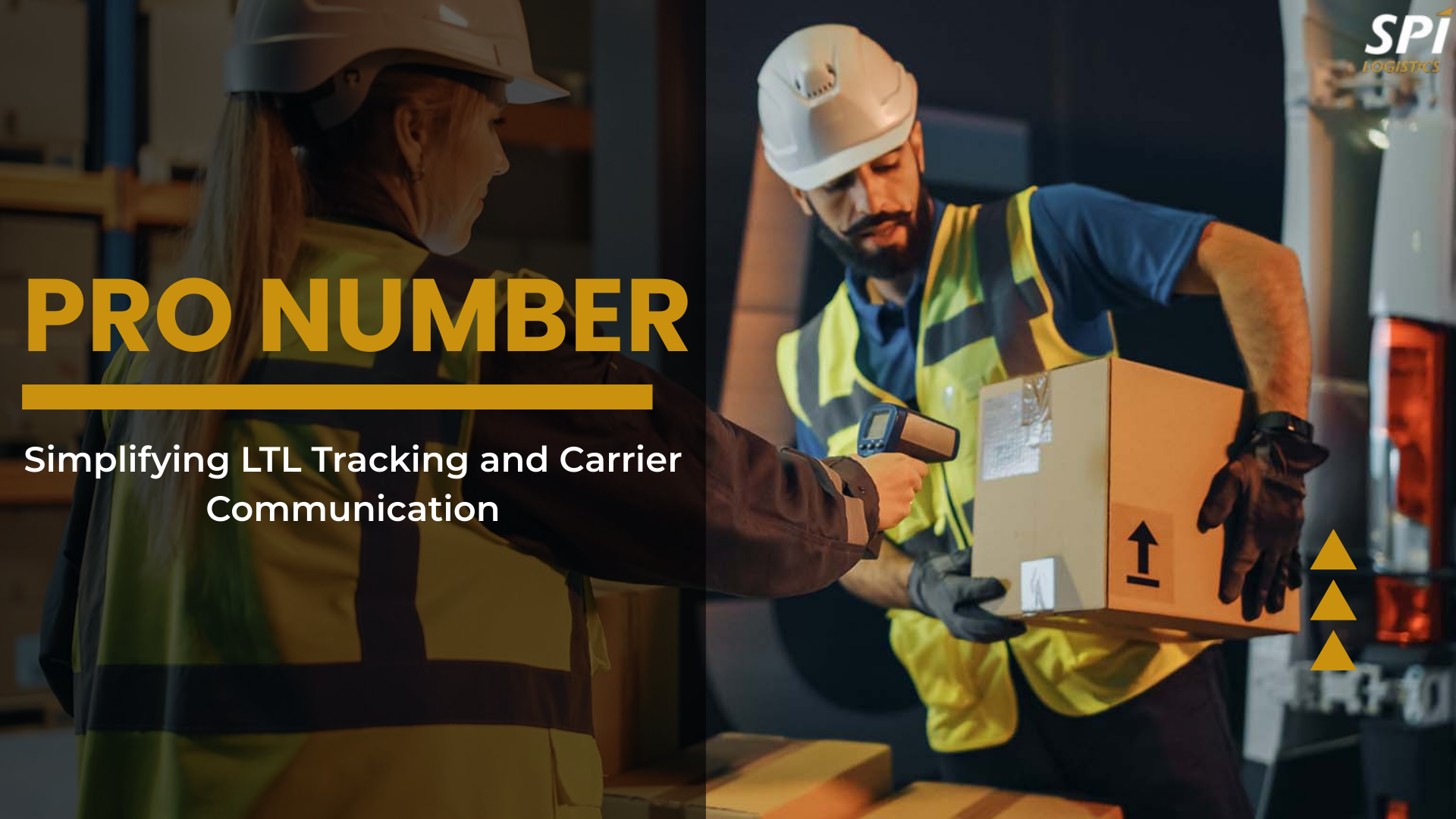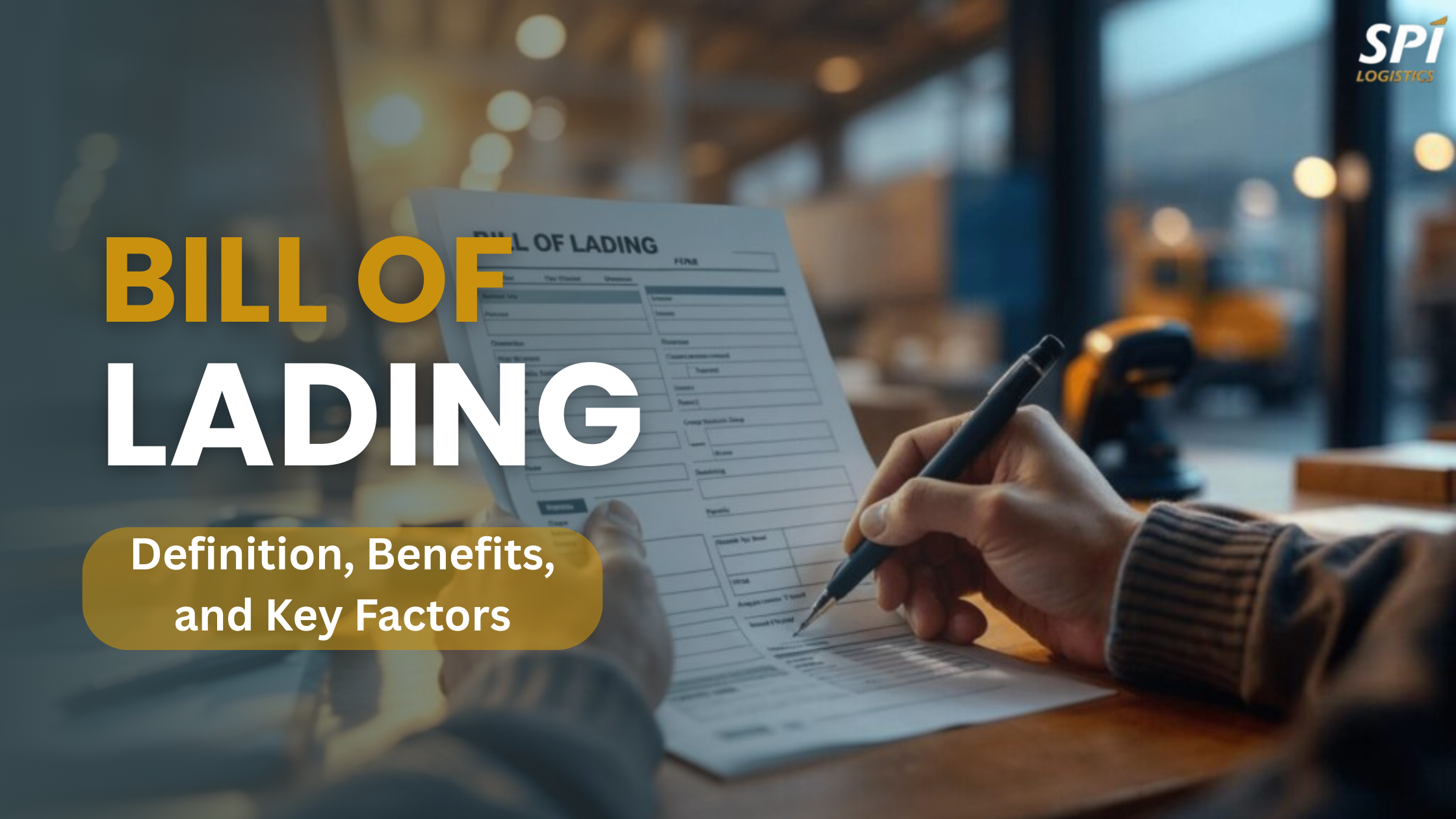In logistics, accuracy and visibility are everything. Whether you’re a shipper, carrier, or broker, knowing what a pro number is in shipping helps you stay in control of your freight from pickup to delivery. This unique identifier ensures every shipment moves through the supply chain seamlessly, reducing delays and confusion.
What Is a Pro Number in Shipping?
A pro number in shipping is a unique identifier assigned by a motor carrier to a specific consignment so it can be located, billed, and verified at every handoff (UPS, n.d.). Unlike a general order ID, a shipping pro number travels with the freight across terminals and linehaul moves, tying physical cartons or pallets to digital events. In practice, it links the movement of a truck shipment to documents like the freight bill number, proof of delivery, and any accessorial charges.
Where it shows up in your workflow:
- On the BOL label, pallet placards, and the carrier’s pickup receipt.
- Inside your TMS as the shipment’s primary lookup key.
- On carrier websites and customer portals used by your team and your consignee (Freightquote, n.d.).
“Treat the pro as the shipment’s passport, everything from linehaul scans to exceptions should be stamped against that number.”
Where do pro numbers currently live in your process (email threads, TMS fields, PDFs), and how could you centralize them for faster lookups?
Benefits of Pro Numbers
Using a pro number in shipping is more than just a tracking convenience, it brings significant operational and financial benefits (FreightWaves, 2023).
Key benefits include:
- Accuracy in billing: Linking each shipment to a freight bill number eliminates invoice disputes (UPS, n.d.).
- Reduced customer service load: Customers self-serve using pro number tracking tools instead of calling in.
- Operational efficiency: Teams manage exceptions faster, especially when ltl freight tracking numbers and common carrier tracking systems are integrated.
- Improved customer trust: Reliable pro shipping tracking builds credibility with shippers and consignees (XPO Logistics, n.d.).
Example: A retailer using automated pro freight tracking reduced missed updates by 40% and improved on-time delivery scores.

“Every automated scan against a pro is a data point you can leverage to improve KPIs like on-time delivery, dwell time, and customer satisfaction,”
Which of these benefits, billing accuracy, service load reduction, or efficiency, would most impact your current operation?
How Pro Numbers Work
Below is a simple lifecycle for a pro, expanded with realistic examples you can adapt.
1. Generation at pickup
The carrier assigns the identifier during dispatch or at the dock, often at the moment freight is scanned. This step turns the load from “scheduled” to “trackable.” In many cases the label/placard with the pro number in shipping is printed and applied before the trailer leaves.
Example: A distributor tenders three pallets of retail goods; the driver scans and the TMS returns PRO 58420317.
2. Attachment to shipping documents and billing
The pro is embedded on the BOL and linked to the freight bill number so every rating or reweigh/repalletize event maps back to the same shipment record. This prevents duplicate invoices and makes claims easier to reconcile (UPS, n.d.).
Example: Your accounting team references the freight bill number tied to PRO 58420317 when matching charges to the customer’s PO.
3. Visibility and status updates
Each terminal scan, arrived, departed, out-for-delivery, posts to the carrier’s system and your TMS. Teams use pro number tracking to check ETAs, exceptions, and delivery appointments without chasing emails (XPO Logistics, n.d.).
Example: Customer service confirms “Arrived at hub at 02:14” using the pro in the carrier portal, then proactively notifies the consignee.
4. Self-serve online tracking
Customers and internal teams can track by pro number via carrier sites, TMS portals, or API automations. This reduces WISMO (“where is my order?”) calls and speeds POD retrieval.
Example: Your buyer logs into the portal, enters the pro, and downloads the POD minutes after delivery.
“Map every milestone, pickup, cross-dock, linehaul, delivery, to the same pro and you’ll slash resolution time on delays.”
Which step in your pro lifecycle causes the most friction, generation, document linkage, status visibility, or self-serve tracking, and why?
Pro Numbers in Trucking and LTL Operations
When it comes to trucking, many ask: what is a pro number in trucking? The answer is similar, it’s the carrier’s way of assigning accountability. In LTL freight tracking, pro numbers become especially important since multiple shipments are consolidated into one trailer.
Key connections include:
- A freight pro number linked to invoices.
- The carrier pro number ensuring each shipment in an LTL load is distinct.
- Advanced freight tracking system tools that unify LTL tracking info with billing.
Benefits for trucking companies and shippers:
- Faster pro freight tracking and reduced lost freight issues.
- Seamless integration with common carrier tracking platforms.
- Reliable LTL tracking number visibility for end customers.
“Using LTL tracking pro numbers in combination with digital dashboards creates a proactive approach to problem-solving.”
Have you found LTL tracking numbers reliable for customer updates, or do you prefer direct carrier portals?
How Pro Shipping Tracking Supports Freight Visibility
The future of freight relies on pro shipping tracking and digital integration. Carriers now offer pro tracking dashboards where shippers can see updates in real time. With the rise of pro freight tracking systems, customers demand fast answers about their deliveries (XPO Logistics, n.d.).
Here’s how to leverage pro numbers for efficiency:
1. Always record your pro number and freight bill number; These two identifiers are the backbone of shipment tracking. For example, if a customer calls asking about a delayed truck shipment, referencing the pro number quickly connects you to the carrier’s system, saving time and avoiding confusion.
2. Use digital tools like LTL freight tracking number lookups; Modern freight tracking systems allow shippers and brokers to enter a pro number into online portals for instant status updates, reducing the need for back-and-forth calls.
3. Implement pro shipping tracking across departments; When sales, customer service, and operations teams all use the same pro numbers, communication improves. For instance, customer service can pull up updates instantly, while operations can use the same data to schedule upcoming loads.
4. Automate updates with a freight tracking number system; Integrating APIs or transportation management systems (TMS) ensures that shipment status updates flow automatically into dashboards, alerts, or emails. This prevents delays caused by manual tracking and builds transparency with customers.

Advantages of using digital tools:
- Consolidates all pro numbers into a single, centralized interface, making it easier for brokers, shippers, and carriers to view shipment updates without juggling multiple systems.
- Minimizes human error in LTL freight tracking by automating data entry, ensuring shipments are linked to the correct freight bill number, and improving overall accuracy.
- Speeds up issue resolution for missed pickups, delivery exceptions, and delays by providing real-time visibility and alerts, allowing customer service teams to proactively update clients and take corrective action (UPS, n.d.).
“Companies that adopt pro number tracking with automation save up to 30% in administrative time per shipment.”
Looking for smarter ways to optimize your freight operations? Explore our freight broker solutions and see how technology can transform your shipping visibility.
Common Challenges with Pro Numbers
Even with benefits, pro numbers can present hurdles if not managed properly.
Common challenges include:
- Duplication: Multiple systems generating different identifiers for the same load.
- Data silos: Pro numbers scattered across emails, spreadsheets, and carrier portals.
- Customer confusion: Shippers mixing up pro numbers with freight bill numbers or ltl tracking numbers.
Example: A manufacturer lost visibility on several shipments because pro numbers were only stored in email confirmations and not entered into their TMS.
“Centralizing pro numbers in a TMS reduces manual entry errors and ensures one source of truth.”
Which of these challenges, duplication, silos, or confusion, causes the biggest disruption in your workflow?
The Future of Pro Number Tracking
As supply chains digitize, pro numbers are becoming smarter. Future advancements include:
- IoT-enabled scans: Pro numbers tied to GPS and sensor data for real-time monitoring.
- AI-driven exception alerts: Predictive analytics using pro number tracking to forecast delays.
- Universal integration: Carriers standardizing LTL freight tracking numbers across networks for seamless visibility (FreightWaves, 2023).
Example: Some carriers now pair pro numbers with IoT devices that report temperature, vibration, and route deviations.

“Tomorrow’s pro numbers won’t just say where your freight is, but also how it’s doing.”
Curious about the future of pro number tracking and how technology is reshaping freight visibility? Explore our freight broker technology solutions to stay ahead of the curve.
Frequently Asked Questions (FAQs)
1. What’s the difference between a pro number and a freight bill number?
A freight bill number is primarily associated with invoicing and billing processes, ensuring financial reconciliation for shipments. In contrast, a pro number serves as a unique identifier for tracking and visibility of a shipment through every stage of the supply chain, connecting it to pickup, transit, and delivery events.
2. Can I track by pro number for all carriers?
Most carriers provide a track by pro number functionality on their websites or portals, allowing shippers and receivers to access real-time shipment information. However, some smaller carriers may require direct contact to obtain status updates or proof of delivery when digital systems are not available.
3. Is a pro number the same as an LTL tracking number?
A pro number is assigned by the carrier to a specific shipment for accountability and tracking, while an LTL tracking number can represent consolidated shipments or be part of a multi-stop load. While related, these numbers serve complementary roles to provide full shipment visibility.
Harness the Power of Pro Numbers
Pro numbers may look like a simple set of digits, but they are the backbone of modern freight tracking. From boosting visibility and reducing delays to ensuring smooth communication between carriers, brokers, and shippers, the shipping pro number ensures efficiency across the supply chain. Whether you’re managing truck shipment operations, handling an LTL freight tracking number, or trying to track by pro number, this system keeps your logistics on track.
Ready to simplify your freight tracking and boost efficiency? Contact us and let our experts guide you toward smarter, more efficient shipping operations.
References
XPO Logistics. (n.d.). Track shipments with PRO numbers. Retrieved from https://www.xpo.com
Freightquote. (n.d.). Freight shipping basics. Retrieved from https://www.freightquote.com
FreightWaves. (2023). The future of LTL tracking and PRO numbers. Retrieved from https://www.freightwaves.com
UPS. (n.d.). UPS Freight PRO numbers explained. Retrieved from https://www.ups.com




